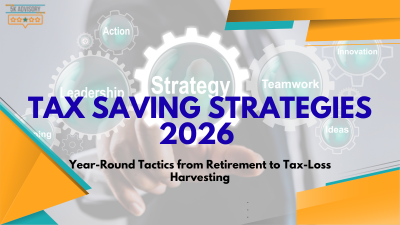The government imposes taxes to fund essential public services, build infrastructure, and support programs that benefit society. While they are a legal obligation, it does not stop individuals and businesses from finding ways to reduce their contribution. The tax saving strategies for individuals are a way to invest more in retirement, education, and personal goals.
Whereas the tax in savings tactic for businesses leads to an increase in profit share and cash flow.
The parties involved in taxes on savings remain fully compliant with the law. Thus, a strong grasp on taxation and tactical planning allows capital stability and resilience, year-round.

How to Explain Taxes? | Tax Saving Strategies
To put it simply, taxes are compulsory payments made to the government, levied on individuals, businesses, and other entities. The finances collected from such means are spent on:
- Public infrastructure, including roads, bridges, and educational institutions.
- Community assistance, like law enforcement, hospitals, fire departments, etc.
- Administration of pensions, social welfare, and unemployment benefits.
- National security and civil protection.
- Settling government loans.
What are the Taxes Imposed On?
- For Individuals: Their income, property owned, purchases carried out, and investments made.
- For Businesses: The profits earned, employee payrolls, and sales at the end of the term.
- For Other Entities: Non-profit organizations, trusts, and inherited estates.
- Excise Taxes: A special type of tax levied on specific goods, like tobacco, alcohol, and other luxury items.
How are the Mandatory Payments Calculated?
- Value Determination
All the salaries, incomes, investments, and other sources eligible for taxes are added up to get the total amount.
- Adjusting the Taxable
The value is reduced once the deductions and exempt components are factored in. Usually, retirement contributions, loans, and mortgage interests are subtracted from the value.
- Applying Tax Rates
The fiscal rates or percentages are applied to determine the actual portion of payment. There are three types of tax rate brackets:
- Progressive system
In which the rates increase with a rise in income.
- Flat system
Under which all entities pay the same percentages, even if their revenues differ.
- Regressive system
Where the tax rates decrease with higher earnings
- Considering the Credits
When credits are allocated, it directly lowers the final taxable amount.
- End-Result
The figure now obtained is the actual tax owed to the government.
What are the Taxes on Saving Strategies?
Correct Comprehension of Taxable
- Jumping into tax is savings without having complete know-how about the taxable puts the taxpayer at a major disadvantage. Consequently, get your facts straight about what taxes you are liable for, then plan your saving strategies.
Maximizing Retirement Accounts
Opening retirement accounts is a great way to lower the share of taxes. For the year 2026, the available plans include:
- A $23000 tax-saving strategy for individuals who are below the age of 50. Also, a $30500 reduction for seniors aged 50 and above.
- Receiving a tax deduction based on income and filing status.
- If the contribution does not fall under tax-deductible, the withdrawals are made tax-free to facilitate long-term benefits.
Full Utilization of Deductibles
The eligible deduction items include:
- A tax-saving strategy for small business owners and remote workers who use their residences for professional or business operations.
- Withdrawals for medical care are accountable for subtractions and complete wipe-offs.
- Student loans, mortgage interest, and property taxes can be reduced within certain limits.
- The charitable do not have any taxes on them.
Optimizing the Credit Options
- Credits directly lower the total amount of taxable calculated. This type of offset is designed for low to moderate-income earners, education, and energy-efficient homes.
- Credits are a great tax-saving strategy for salaried employees or parents who have signed up for childcare expenses.
Understanding Tax-Loss Harvests
This is among the tax-saving strategies for high-income earners who wish to reduce capital gain taxes. Tax-loss harvesting consists of selling investments that have diminished in value and balancing them out with profits from other investments in the portfolio.
Opportunities in Business Expenses
One of the tax-saving strategies for small business owners that deduct:
- Cost of business asset over time or depreciation
- Cost of equipment purchased in the current year
- Work-related travels and meals
- Household operating expenditures for business.
Frequently Asked Questions
What are the best tax saving strategies?
The tax-saving strategies depend on the criteria. If you are an individual or a business, the methods differ.
What lowers your taxes the most?
The factors that help lower the tax share include the type of income, the current situation, and the tax laws set by the country.
What is the most tax-efficient way of saving?
The use of accounts and techniques that maximize the amount of money you truly hold.
What is the most effective method of decreasing taxes?
The methods that lower the portion of taxable income or direct taxes owed.
Parting Wisdom About Tax Saving Strategies
If you are not aware a lot about tax in saving, talk an expert at 5K Advisory. Not only, they are well-versed in taxes on savings, but also, know many important tax saving strategies for small businesses.

